The Jin-Yuan Period 1115 - 1368 AD
* The Jin Dynasty 1115 1234 AD 1234 AD
* The Yuan Dynasty 1279 1368 AD 1368 AD
About Jin and Yuan
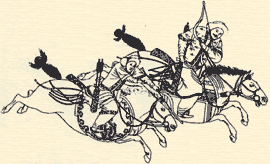
Mongol Horsemen Hunting |
The Jin and the Yuan were neighboring nomadic non-Chinese tribes who lived in the north-east of the empire during the Song Dynasty before they developed their own powerful kingdoms. The Jin Dynasty was founded by a Tanguts tribe in 1115 and conquered the northern part of China in 1126. This situation prevailed for more than one-hundred years until a strong Mongol army overthrew the Jin in 1234. The Mongols then defeated the Southern Song in 1279, taking over the whole region to found the vast Yuan Empire. During this time, China was totally under foreign rule and historians refer to the period as the Jin-Yuan.
In the 13th century, the Mongols rose to power under the leadership of Genghis Khan. Under his successor, his third son Ogodei (1227-41), as Great Khan, led Mongol armies into Europe as far as Poland and Hungary. In 1279, it was the grandson of Genghis Khan, Kublai Khan, who founded the Mongol Dynasty, giving it the Chinese name of Yuan, and established his capital in Beijing. Under Mongol rule, the kingdom proved disjointed and divided. There were nine rulers who held the throne during this short period and as a result power was weakened. Chinese officials were once again able to gain a foothold when in 1368 a rebel Chinese group, the Red Turbans, ended the Yuan Dynasty.
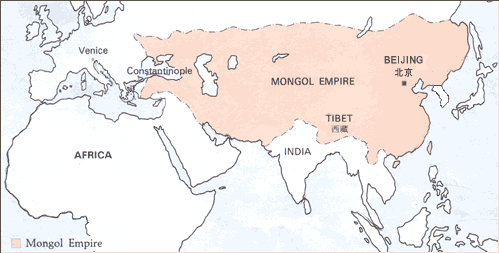
Map of Mongol Empire |
The culture, art and lifestyle of the country during the period remained basically the same as it had during the Song Dynasty, but the prosperity of the previous dynasty began to fade. The Jins wiped out some of the Song's most talented artists. Creativity and inventiveness began to disappear. Under Mongol rule, a whole new set of rules and customs were created. The Mongols prohibited marriage between different ethnic groups and heavily taxed the peasants. In response to what they considered unjust and unfair treatment, a number of religious societies, including Buddhist-based associations, revolted.
On the positive side, Mongol rulers imposed a strictly regulated system of medical practice and banned the use of certain toxic drugs. In 1268, for example, the sale of aconite and arsenic was forbidden. The Mongols also helped open trade in the region known today as the Middle East. One of the best-known explorers of the time was MarcoPolo. The Italian-born explorer was the first European to really journey through the Asian continent.
Prominent physicians
During this period, several schools of thought evolved attributing disease to different factors, and advocating contrasting approaches to treatment. This was in addition to the Mongol physicians who held their own set of beliefs. Nevertheless, a number of physicians living at this time made a significant contribution to medical development.
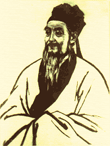
Liu Wansu
(1120-1200 AD) |
Master Hejian (Liu Wansu)
Liu Wansu (1120-1200), or Master Hejian as his students called him, is credited with founding the Hejian School. A native of Hebei province, he three times turned down an offer from the Jin emperor to practice medicine for the palace and chose instead to practice medicine for the people. He played a significant role in the development of Chinese medicine and is famous for writing a number of works based on the medical classic the Suwen (The Book of Plain Questions).
Liu Wansu's belief centered on the theory of the five movements (yun) and six influences (qi). He placed particular importance on the elements of fire and heat, and tended to prescribe herbs that have cold properties to treat disease arising from these influences.This is also referred to as the "School of cooling" for the reason. Examples of his frequently prescribed herbs are cassia twig,rehmannia root, ephedra and mint.
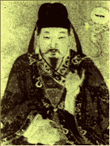
Zhang Congzheng
(1150 - 1228 AD) |
Six Doors and Three Methods (Zhang Congzheng)
Zhang Congzheng (1150-1228) had an innovative approach to medical treatment and insisted that the medicines of yesterday could not combat present-day illnesses. He was a military physician and wrote a book called Rumen Shiqin (Therapies for Scholars) based on his observations and research. However, he is best known for his theory of the "six doors and three methods." The six doors are the six influences (wind, summer heat, dampness, fire, dryness and cold) that Liu Wansu observed, and the three methods refer to therapeutic regimens used to induce sweating, vomiting and purging, that Zhang resorted to frequently. He thought that evil influences were derived from the heavens, the earth and man's behavior (e.g. what he ate). In order to effect a cure, the evil influences had to be expelled.
Master of the Yishui School (Zhang Yuansu)
Zhang Yuansu (1151-1234) was the founder of the Yishui School, named after his native district in Hebei province. According to his book Yixue Qiyuan (Explanation of Medicine) published in 1186, "the prescriptions of the past were not appropriate for the illnesses of today." However, Zhang created a unique mosaic of his own practices and beliefs based on the teachings of his predecessors in medical classics such as the Huangdi Neijing (The Yellow Emperor's Classic of Internal Medicine), the Shanghanlun (Treatise on Febrile Diseases) and the Zongzangjing . Zhang Yuansu was known for his idea that medicine has specific effects on particular meridians. He thought illness occurred when there was an imbalance of zang and fu organs. By understanding the pathological conditions of the organs, a diagnosis could be made and appropriate therapy could be chosen.
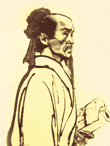
Li Gao
(1180 - 1251 AD) |
The Old Gentleman of the Eastern Wall (Li Gao)
Li Gao (1180-1251) had been fascinated by medicine since childhood. Li, who came from a wealthy family, is known for his concern about how lifestyle affects the body's organs. In his most important work, Piweilun (Treatise on the Spleen and Stomach), he stated that if the spleen and the stomach were injured by an inappropriate lifestyle, vitality would decline and illness would result from an imbalance of qi in these organs. He was a strong believer that a person's emotions, including anger, joy, sadness and grief, could heavily influence the qi, and that illness was caused by a society marred by poverty, war and oppression. He was a proponent of the use of several tonics and especially recommended ginseng.
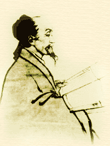
Zhu Zhenheng
(1281 - 1358 AD) |
Minister of Fire (Zhu Zhenheng)
From Zhejing province, Zhu Zhenheng (1281-1358) was also known as Master Danxi. He undertook a systematic study of medicine and his work, Gezhi Yulun (Theories of In -depth Research), studies the theory of internal fire or heat during physiological and pathological change in the body. Minister-fire is a kind of yang energy that is a vital force necessary for the body to function. It mainly exists in the liver and kidneys. It cooperates with the second fire, "master-fire" or heart-fire, to promote the function of the organs. In illness, Zhu Zhenheng thought that the body's yang was usually in excess causing yin to become deficient. As a result, "fire" in the body, which is normally produced by movement, was increased during the course of disease and was thought to be due to disharmony of the minister-fire. As a yang excess was thought to be harmful because it consumes yin, nourishing the yin and quenching the fire were the chief measures of treatment. Zhu Zhenheng strongly recommended appropriate diet and sexual activities in order to preserve the yin. This theory of "minister fire" is still used today in TCM.
Acupuncture and Moxibustion

Location of Acupoint Jiuwei |
In the Jin-Yuan period, acupuncture and moxibustion were used extensively and various acupuncture points and their corresponding therapeutic virtues were validated further. Procedures in applying acupuncture and moxibustion to these points had been developed differently over the centuries. Four Books of Acupuncture and Moxibustion (Zhenjiu Sishu) published by Dou Guifang in 1331 compiled important works written during the Song and Jin Dynasties on acupuncture. For example, a point known as jiuwei (see picture) mentioned in Huangdi Mingdang Jiujing (one of the four books) was used in treatment of palpitations and epilepsy, a point whose use is endorsed by contemporary acupuncture practice for similar indications.
It was not only the Chinese who made discoveries and developed new theories regarding acupuncture and moxibustion. The Mongols also contributed to medical knowledge. Therapeutic methods like Mongolian moxibustion and blood-letting were very popular at that time.
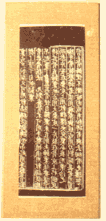
A copy from Shiyi Dexiaofang
(Efficacious Remedies of the Physicians) |
Bone Setting and Traumatic Surgery
Nomadic Mongols were involved in continuous military activity and this further facilitated the development of external medicine. During the Yuan Dynasty, Qi Dezhi and his work Waike Jingyi (The Essentials of External Medicine), dating from 1335 AD, represented the achievement of the time. Although the book outlines various therapeutic methods using minor surgery, it lists remedies making use of decoctions, pills, powders and ointments and is more a treatise on dermatology than surgery. He believed that disorders of the skin were a consequence of imbalance in yin and yang. Phytotherapy (use of herbs) was an integral part of Qi Dezhi's approach.
Wei Yilin (c. 1277-1347) a contemporary of Qi Dezhi specialized in orthopedics. His book Shiyi Dexiaofang (Efficacious Remedies of the Physicians) is a testimony to Wei's skills in setting fractures and in treating dislocations of the shoulder, hips and knee. He also made occasional use of anesthetic drugs and pioneered the suspension method for joint reduction. It was not until 1927 that this was introduced into Western medicine by the British doctor, Davis.
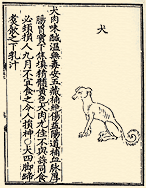
Dogmeat from Yinshan Zhengyao (Important Principles of Food and Drink) |
Eating for Health the Chinese Way
Hu Sihui, a Mongol, is credited for being a distinguished dietician. He wrote Yinshan Zhengyao (Important Principles of Food and Drink) in 1330 and was a proponent of a balanced diet. He especially focused on the importance of moderation and championed the eating in moderation rule. In addition, Hu's book offered a list of 230 cereals, meat, fish, shellfish, fruits and vegetables with a description of their nutritional benefits. For example, Hu said that eating too many apples caused distension and too many oranges could harm the liver; that dog meat was salty, not too overpowering, non-toxic and calmed the zang organs; and that grapes sustain energy and strengthen character.
Other Important Works
Other practitioners during the Jin-Yuan period included Ge Keijiu (1305-52) who wrote a treatise, the Shiyao Shenshu (1348), on tuberculosis and Zeng Shirong whose book Houyou Xinshu (1294) expanded the study of pediatrics from the Song Dynasty.
|